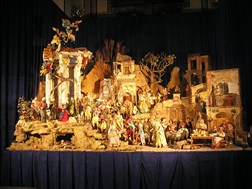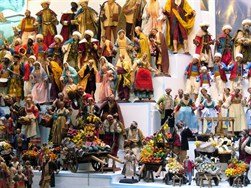The origin of the Nativity scene and its spread
 The Nativity scene is the most famous, widespread (and indeed, rediscovered in recent decades) representation of the birth of Jesus throughout the Christian world. The Italian term presepe derives from the Latin praesepe, indicating a manger or even a fence. The reconstruction of the nativity scene, which depicts the Holy Family, the ox, the ass, the Three Kings and other supporting characters (shepherds, merchants, farmers, etc.) is based on the accounts of the Gospels of Matthew and Luke.
The Nativity scene is the most famous, widespread (and indeed, rediscovered in recent decades) representation of the birth of Jesus throughout the Christian world. The Italian term presepe derives from the Latin praesepe, indicating a manger or even a fence. The reconstruction of the nativity scene, which depicts the Holy Family, the ox, the ass, the Three Kings and other supporting characters (shepherds, merchants, farmers, etc.) is based on the accounts of the Gospels of Matthew and Luke.
If some images of the nativity made in the catacombs of Rome go back to the fourth century, and if it is historically established that in the Middle Ages and then increasingly from the tenth century onwards, religious images were displayed in churches all over Europe on Christmas Day, the first nativity scene in history which is commonly referred to is the representation desired by Francis of Assisi in 1223. Nevertheless, the Holy Family was not present in the saint’s “Nativity scene”, but only a real donkey and an ox that Francis had brought out of his convent of Greggio, in a manger built inside a cave in a forest. Examples of Nativity scenes dating back to the Middle Ages and the Early Modern period are still present in various locations in Europe (as in the case of the Nativity scene of the Basilica of Santo Stefano in Bologna, or the one in alabaster made by Arnolfo da Cambio in 1289 and kept in the Sistine Chapel of the Church of Saint Mary Major in Rome), but the real golden age in the history of the Nativity scene goes back to the seventeenth and eighteenth centuries.
 The Jesuits were great promoters of these Christmas scenes, who contributed to their spread throughout Catholic Europe. The size and magnificence of the Baroque and seventeenth Nativity scenes could be seen not only in Mediterranean Europe, but also in Central and Eastern Europe, especially in the Germanic area, in the south of Germany and in Austria. At the end of the eighteenth century, the Nativity scene was struck by the struggle for secularization carried out by the theories of the Enlightenment: in many places Nativity scenes were banned, many were destroyed and others were saved only by the intervention of individual believers or passionate collectors. Gradually rediscovered during the twentieth century, the Nativity scene is now considered an integral part of the folk tradition of Catholic Europe. If in Germanic lands, such as in the Diocesan Museum in Bressanone or in the National Museum of Munich in Bavaria, there are many examples of splendid Nativity scenes from central and northern Europe, for the Mediterranean area the nativity scene’s most famous and most traditional bastion is definitely the Neapolitan region (although other prestigious Nativity scene traditions are also present in Genoa and Bologna). The influence of the Neapolitan Nativity scene is also very strong in Spain.
The Jesuits were great promoters of these Christmas scenes, who contributed to their spread throughout Catholic Europe. The size and magnificence of the Baroque and seventeenth Nativity scenes could be seen not only in Mediterranean Europe, but also in Central and Eastern Europe, especially in the Germanic area, in the south of Germany and in Austria. At the end of the eighteenth century, the Nativity scene was struck by the struggle for secularization carried out by the theories of the Enlightenment: in many places Nativity scenes were banned, many were destroyed and others were saved only by the intervention of individual believers or passionate collectors. Gradually rediscovered during the twentieth century, the Nativity scene is now considered an integral part of the folk tradition of Catholic Europe. If in Germanic lands, such as in the Diocesan Museum in Bressanone or in the National Museum of Munich in Bavaria, there are many examples of splendid Nativity scenes from central and northern Europe, for the Mediterranean area the nativity scene’s most famous and most traditional bastion is definitely the Neapolitan region (although other prestigious Nativity scene traditions are also present in Genoa and Bologna). The influence of the Neapolitan Nativity scene is also very strong in Spain.
